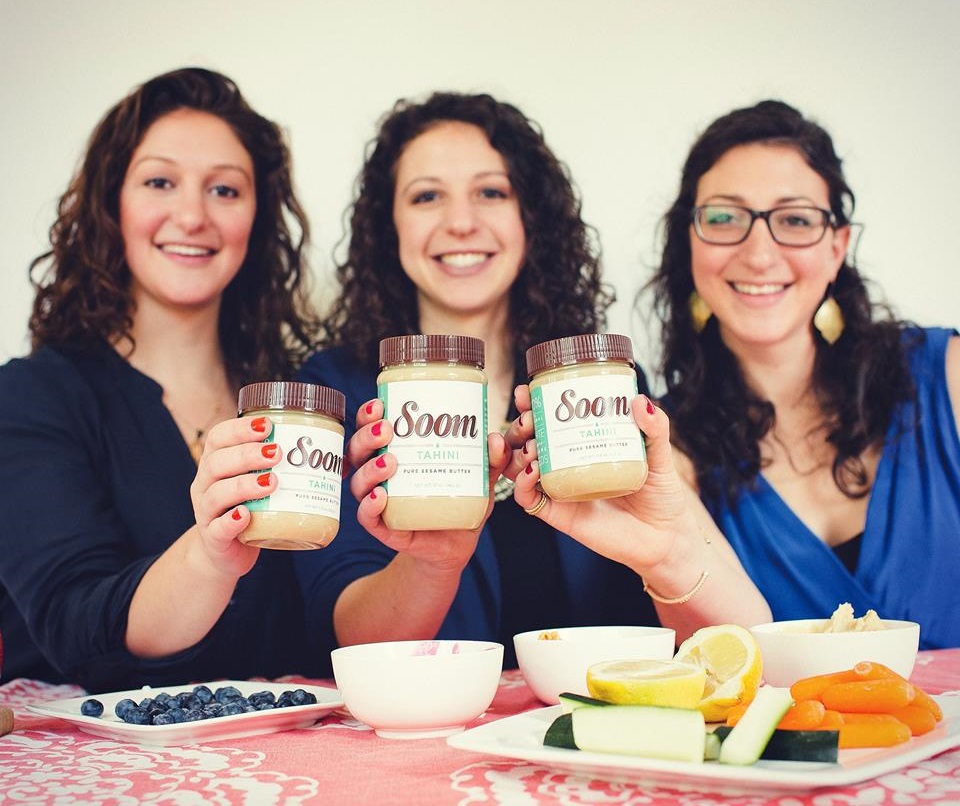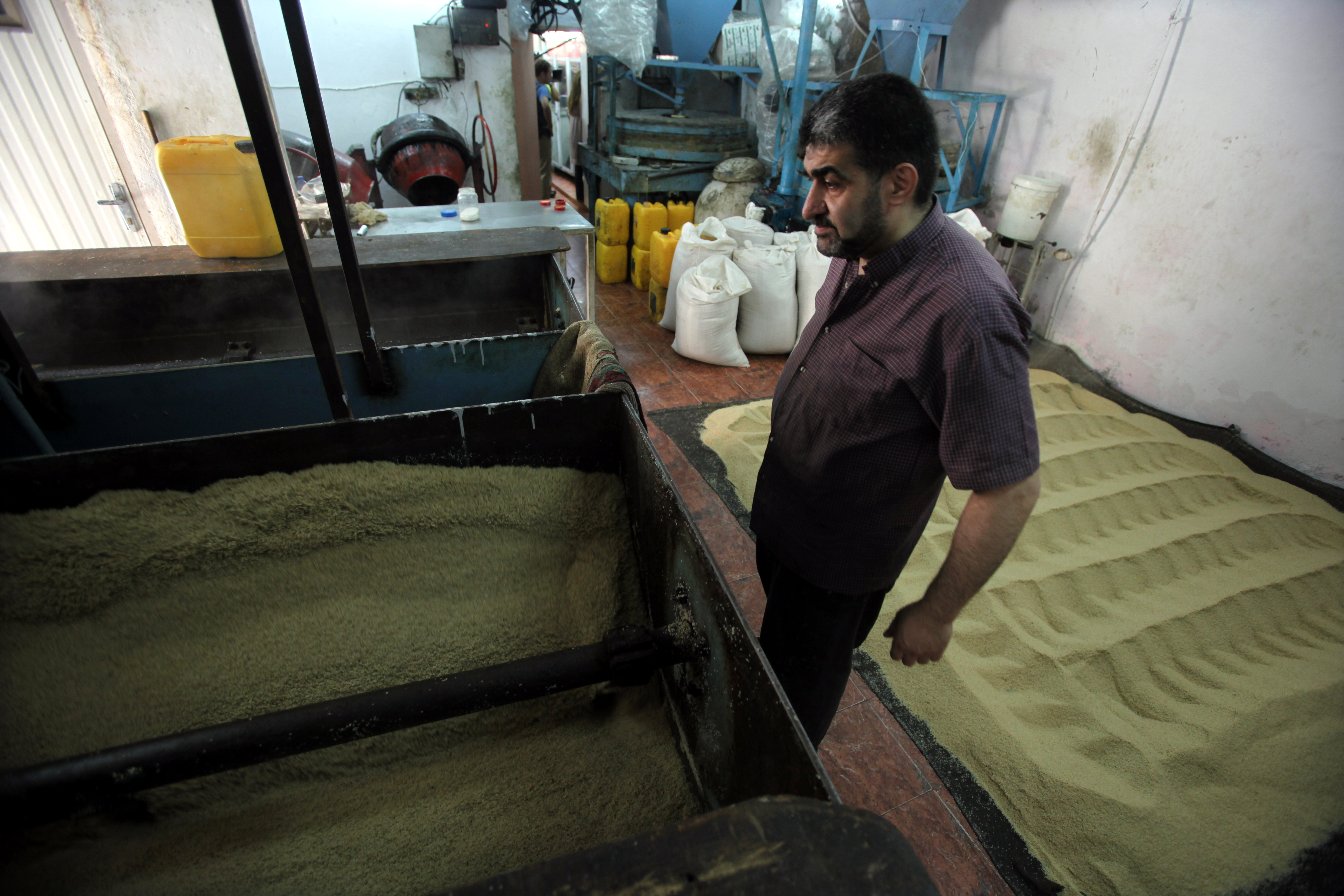A mouthwatering paste made from ground sesame seeds, tahini has long been a staple of Middle Eastern cuisine. Now, this creamy condiment is capturing hearts continents away.
When Jackie Zitelman’s two sisters came to visit her in Israel, she took them to her boyfriend’s moshav, where his mother served them her homemade carrot cake. But this wasn’t the American carrot cake the three sisters from Maryland were used to. In an Israeli twist, it contained tahini, or sesame paste. Called tehina in Hebrew, the sisters associated it with hummus and falafel, not baked goods.
“They just couldn’t believe that tehina was in this cake,” Zitelman recalls. “They loved it.”
The cake wasn’t made with just any tahini. It was tahini that Zitelman’s then-boyfriend, Omri Horvitz, a food distributor, imported from Ethiopia. After the meal, he took Zitelman’s sisters on a tour of his storage facility, letting them taste spoonfuls of raw tahini, made from roasted and crushed sesame seeds with no additives.
This experience, they say, is what first inspired them to found the company Soom Foods in 2012. Named after the Hebrew word for “sesame,” Soom makes tahini in Israel with sesame seeds from Ethiopia for export to the United States.
“We wanted to have something like this in the U.S.,” Zitelman, now 29 and married to Horvitz, says. “We wanted to educate the U.S. market on what is tehina. It’s so nutritious. It’s versatile. It can be used in sweet dishes, in savory dishes. It’s a staple.”
Soom’s products are now used by numerous leading chefs in the U.S., including Michael Solomonov in Philadelphia and Alon Shaya in New Orleans. It is sold in two flavors—plain and chocolate—at health food stores and certain Whole Foods Markets across the U.S., as well as online.
“Our goal was to make tehina more than a product you find in a kosher market,” Zitelman says. The sisters are working on developing more flavors as the company continues to grow.

Jackie Zitelman Horvitz, Amy Zitelman, and Shelby Zitelman of the Philadelphia-based Soom Foods. Photo: Soom Foods / Facebook
They attribute their success to the rising popularity of tahini in the U.S. The food is being embraced not just as a key component of hummus, but also as an ingredient in baked goods, salad dressings, dips, and other dishes.
The global tahini market is growing by more than five percent a year, according to a report from Persistence Market Research. Mainstream websites and magazines like Epicurious, Martha Stewart Living, and Buzzfeed are full of tahini recipes. Artisanal tahini makers have popped up in the U.S., including Seed & Mill and Brooklyn Sesame, both in New York. Last year, Short Stack Editions, the popular series of cookbooks, published a volume dedicated to tahini. It not only instructs readers on how to make authentic hummus, but also tahini-crusted shrimp and chocolate-tahini truffles.
Adeena Sussman, a food writer who splits her time between New York and Tel Aviv, is the author of Short Stack’s Tahini cookbook, as well as co-author of the best-selling Cravings and The Sprinkles Baking Book. She says it is both the exotic and familiar nature of tahini that draws so many people to it. In addition, sesame paste is a diverse ingredient, used in Asian, African, and Balkan cooking.
“Tahini is something fresh and different, but the base of it is something everyone knows—sesame seeds,” Sussman says. “It’s also very wholesome and healthy.”
Tahini has been a staple of Middle Eastern cuisine for millennia, with references to it found on 4,000-year-old cuneiform tablets discovered in what is now Iraq. The root of the word, in both Hebrew and Arabic, means “to grind,” and refers to how sesame seeds are ground into a creamy paste.
Down a small alley in Jerusalem’s Old City near the Damascus Gate is a small convenience store that sells candy bars, yogurts, and cold drinks. But this is more than a simple convenience store. A door in the corner leads to another room where a round stone about five feet in diameter goes round and round, grinding sesame seeds into paste. Although there is no sign on the door, this is the Jebrini Tehina Factory. Started 142 years ago, this hidden treasure, a living museum, showcases the now-dying traditional way of making tahini.
After years working in food factories in Jerusalem’s Givat Shaul neighborhood, 53-year-old Ishak Jebrini took over his family’s tahini business around a decade ago. It takes a few days to produce a container of tahini, he says. First, sesame seeds are soaked in a bin of salt water for at least a day in order to clean them. After this, they are left to dry for 24 hours, then put into saltwater again. They are crushed with metal bars, which causes the shells to come off and sink to the bottom, leaving the kernels to float. The kernels are then removed, rinsed, and left to dry for another day before being roasted for three hours in a large dome-shaped taboon oven. After roasting, they are placed under the circular grinding stone, where over several hours they are crushed into a paste, ready to put in a jar.
“The taboon oven gives our tahini a really unique taste,” Jebrini says. The only thing that has changed since his great-grandfather’s day is that the grinding stone and steel bars that crush the seeds are now run by electricity, he adds.

Tahini being made at Ishak Jebrini’s factory in the Old City of Jerusalem. Photo: Yossi Zamir / Flash 90
This little factory can make about 65 pounds of tahini a day, he says, while modern industrial operations can churn out some 450 pounds an hour. But Jebrini has no plans for change.
“We don’t want to make this a big business,” he says, as he walks around mounds of sesame seeds that have just come out of the oven, waiting their turn for the grinding stone. “We are in the Old City, so it’s hard to bring in big equipment here. This place isn’t big enough for a big business.”
Although there are a few operations like Jebrini’s left, most of Israel’s growing tahini production happens on a much larger scale. In fact, in recent years, Israel has emerged as one of the world’s leading producers of tahini. In 2016, tahini exports brought $30.5 million to Israel. While most was destined for the U.S. market, it was also exported to Australia, Italy, Hong Kong, and Taiwan, according to the Israel Export and International Cooperation Institute, a government agency that facilitates trade, cooperation, and joint ventures between Israeli and international companies.
This has led to changes in the way Horvitz does business. A few years ago, he switched from importing ready-made tahini paste to importing sesame seeds from Ethiopia to supply the growing number of Israeli tahini factories.
“All the time there is more and more demand,” Horvitz says, with new factories opening and existing ones adding more production lines.
He specializes in Hamara sesame seeds, which have a reputation for quality and are the base for most Israeli-produced tahini. The seeds arrive at Israel’s ports in Haifa and Ashdod packed into 110 pound bags. One shipping container can hold up to 19 tons of sesame seeds. Most large factories, including the one that makes Soom’s tahini, no longer rely on salt water to clean and separate the seeds. Instead, a machine sprays them with high-pressure fresh water. This is not only more efficient, but also results in less environmental damage, as disposal of large amounts of salt water can contaminate soil. In some cases, the sesame seeds are crushed into paste using metal grinders, rather than the stone wheel seen in Jebrini’s factory. But there is still a lot of nostalgia for the old way of tahini production, and some modern factories use stone grinders.
Among the new operations in Israel is Artzieli Tehina, opened three years ago in Eilat. Intended to be a boutique producer, the factory custom-built its production line rather than purchase industrial equipment. It incorporates traditional methods of production, such as using a stone grinder. But to make their grinder more productive than the antique one in Jebrini’s factory, the company added layers of marble and concrete to increase the weight of the stone to nearly one ton, increasing the amount of sesame it can grind each hour.
“Our idea was to make something of higher quality, to be a boutique,” one of Artzieli’s managers told me. “Yes, there are a lot of tehina factories in Israel, but to open a new one is like opening a new restaurant even though there are a lot of restaurants already. It’s about taking it to the next level, offering something different.” For now, Artzieli only sells tahini locally, but it hopes to eventually break into the growing global market.
Israel is not only a major producer of tahini. It is also a center of culinary creativity. Tahini is often a focus of the growing number of food tours around the country.
Israel is not only a major producer of tahini. It is also a center of culinary creativity.
“It’s amazing how much more familiar with it tourists have become,” says Inbal Baum, CEO and founder of Delicious Israel, a Tel Aviv-based food tour company founded six years ago. “I no longer need to always explain what tehina is.” Rather than sampling halva—a traditional Middle Eastern sweet made from sesame paste mixed with sugar or honey—or hummus made with tahini, she finds that her audience is eager to see what new things people are doing with it. She points out that Israeli chefs are blending it with beets to make a creamy bright pink salad dressing, or serving a scoop of tahini mixed with date honey to finish off a heavy meat-based meal. Even at the famous Halva King shop in Jerusalem’s Mahane Yehuda market, a traditional favorite among tourists and locals for decades, they are getting more creative with flavors. Halva spiced with za’atar, a Middle Eastern spice blend that includes thyme, is now among the 100 flavors they offer.
“In terms of popularity, I really think it’s the next hummus, and that this trend and the awareness of it is only in its infancy,” Baum says.
Many of the chefs, recipe-developers, and food producers popularizing tahini in the U.S. have roots in Israel. But they have taken tahini far beyond traditional Israeli or Middle Eastern food. At Domenica restaurant in New Orleans, billed as Italian but owned by Israeli-born Alon Shaya, the southern staple of okra is mixed with eggplant and topped with tahini. At Mill & Seed in New York’s Chelsea market, which is co-owned by former Tel Avivian Lisa Mendelson, one can find chocolate and sea salt halva and goji berry halva. And Sussman offers a recipe for sandwich cookies filled with tahini frosting. Word about Soom and tahini in general has spread beyond those connected to Israel, Sussman points out. Soom tahini is used to make several dishes at the popular Mission Chinese Food restaurant.
The fact that serious chefs have embraced Soom has helped give the company a boost, the sisters say. Chief among them is Michael Solomonov, the Israeli-born chef whose Zahav restaurant in Philadelphia opened in 2008, winning a coveted James Beard award in 2011 and attracting media coverage from The New York Times, Esquire, and Condé Nast Traveler. In 2015, the cookbook Zahav: A World of Israeli Cooking by Solomonov and his business partner Steven Cook won numerous awards and recognitions.
“Once chefs started talking about good tahini, people started listening,” says Jackie Zitelman’s sister Amy, who runs most of Soom’s marketing. “We are forever appreciative to Michael Solomonov and Steve Cook for mentioning Soom in their cookbook, Zahav. It is, to this day, our biggest referral source.”
In fact, the sisters credit Solomonov as one of the inspirations for founding Soom. “Michael was nice enough to meet with us during our market-research stage, and we had the opportunity to ask him what tahini he was using at the restaurant,” Amy Zitelman recalls. “When he told us they didn’t like the tahini options they had, he pretty much gave us his blessing to go out and bring some.”
Almost everyone involved with tahini sees its popularity as more than a passing trend. Jebrini, taking a break from manning his factory in the Old City to sell two big jars of tahini and sesame oil to a European tourist, says that once people learn about its health benefits, they will keep it as part of their diet.
“I know people are mixing it with all kinds of things now, chocolate and other things, but at the end of the day, it’s about health,” he states.
The sisters behind Soom say they will continue their site’s popular blog and their collaboration with chefs in order to educate the public about this flexible and healthy ingredient.
“It’s not just trendy,” Zitelman says. “It’s a product people can use. It’s a chef’s food and it’s a staple. We want people to have tahini in their cabinet like they have ketchup.”
Market studies indicate that Israel will face more competition in the coming years from other tahini-producing countries, including those in Mediterranean Europe and the Persian Gulf. But for now, Israel remains at the center of the culinary world’s love affair with tahini.
![]()
Banner Photo: alex9500 / Adobe Stock






